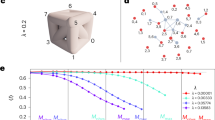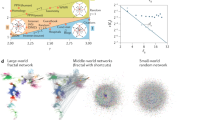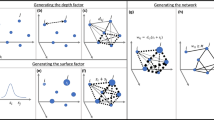Abstract
While the structural characteristics of a network are uniquely determined by its adjacency matrix1,2,3, in physical networks, such as the brain or the vascular system, the network’s three-dimensional layout also affects the system’s structure and function. We lack, however, the tools to distinguish physical networks with identical wiring but different geometrical layouts. To address this need, here we introduce the concept of network isotopy, representing different network layouts that can be transformed into one another without link crossings, and show that a single quantity, the graph linking number, captures the entangledness of a layout, defining distinct isotopy classes. We find that a network’s elastic energy depends linearly on the graph linking number, indicating that each local tangle offers an independent contribution to the total energy. This finding allows us to formulate a statistical model for the formation of tangles in physical networks. We apply the developed framework to a diverse set of real physical networks, finding that the mouse connectome is more entangled than expected based on optimal wiring.
This is a preview of subscription content, access via your institution
Access options
Access Nature and 54 other Nature Portfolio journals
Get Nature+, our best-value online-access subscription
$29.99 / 30 days
cancel any time
Subscribe to this journal
Receive 12 print issues and online access
$209.00 per year
only $17.42 per issue
Buy this article
- Purchase on Springer Link
- Instant access to full article PDF
Prices may be subject to local taxes which are calculated during checkout




Similar content being viewed by others
Data availability
Source data are provided with this paper. All other data that support the plots within this paper and other findings of this study are available from the corresponding author upon reasonable request.
Code availability
Code is available for this paper at https://github.com/YanchenLiu1/GLN. All other code that support the plots within this paper and other findings of this study are available from the corresponding author upon reasonable request.
References
Cohen, R. & Havlin, S. Complex Networks: Structure, Robustness and Function (Cambridge Univ. Press, 2010).
Caldarelli, G. Scale-free Networks: Complex Webs in Nature and Technology (Oxford Univ. Press, 2007).
Dorogovtsev, S. N., Goltsev, A. V. & Mendes, J. F. Critical phenomena in complex networks. Rev. Mod. Phys. 80, 1275–1335 (2008).
Song, C., Wang, P. & Makse, H. A. A phase diagram for jammed matter. Nature 453, 629–632 (2008).
Barthélemy, M. Spatial networks. Phys. Rep. 499, 1–101 (2011).
Barrat, A., Barthelemy, M. & Vespignani, A. Dynamical Processes on Complex Networks (Cambridge Univ. Press, 2008).
Whitney, H. Collected Papers of Hassler Whitney (Nelson Thornes, 1992).
Armstrong, M. A. Basic Topology (Springer Science & Business Media, 2013).
Gauss, C. F. in Zur Mathematischen Theorie der Electrodynamische Wirkungen Collected Works, Vol. 5, 605 (Koniglichen Gesellschaft des Wissenschaften, 1833).
Kauffman, L. Knots and Physics, Series on Knots and Everything 1 (World Scientific, 1991).
Bianconi, G. & Capocci, A. Number of loops of size h in growing scale-free networks. Phys. Rev. Lett. 90, 078701 (2003).
Viana, M. P. et al. Mitochondrial fission and fusion dynamics generate efficient, robust, and evenly distributed network topologies in budding yeast cells. Cell Syst. 10, 287–297 (2020).
Gagnon, L. et al. Quantifying the microvascular origin of BOLD-fMRI from first principles with two-photon microscopy and an oxygen-sensitive nanoprobe. J. Neurosci. 35, 3663–3675 (2015).
Cook, S. J. et al. Whole-animal connectomes of both Caenorhabditis elegans sexes. Nature 571, 63–71 (2019).
Xu, C. S. et al. A connectome of the adult Drosophila central brain. Preprint at https://doi.org/10.1101/2020.01.21.911859 (2020).
Lein, E. S. et al. Genome-wide atlas of gene expression in the adult mouse brain. Nature 445, 168–176 (2007).
Dehmamy, N., Milanlouei, S. & Barabási, A.-L. A structural transition in physical networks. Nature 563, 676–680 (2018).
Dubrovin, B., Fomenko, A. & Novikov, S. Modern Geometry Methods and Applications. Part 1: The Geometry and Topology of Manifolds (trans. Burns, R. G.) (Graduate Texts in Mathematics 104, Springer-Verlag, 1984).
Mézard, M. & Parisi, G. Replica field theory for random manifolds. J. Phys. I 1, 809–836 (1991).
Parisi, G. The physical meaning of replica symmetry breaking. Preprint at https://arxiv.org/abs/cond-mat/0205387 (2002).
Fraenkel, A. S. Complexity of protein folding. Bull. Math. Biol. 55, 1199–1210 (1993).
Ngo, J. T., Marks, J. & Karplus, M. in The Protein Folding Problem and Tertiary Structure Prediction (eds Merz K. M. & Le Grand S. M.) 433–506 (Springer, 1994).
Bullmore, E. & Sporns, O. The economy of brain network organization. Nat. Rev. Neurosci. 13, 336–349 (2012).
Kubicki, M., McCarley, R. W. & Shenton, M. E. Evidence for white matter abnormalities in schizophrenia. Curr. Opin. Psychiatry 18, 121 (2005).
Zalesky, A. et al. Disrupted axonal fiber connectivity in schizophrenia. Biol. Psychiatry 69, 80–89 (2011).
Del Ferraro, G. et al. Finding influential nodes for integration in brain networks using optimal percolation theory. Nat. Commun. 9, 2274 (2018).
Smaldino, P. E., D’Souza, R. M. & Maoz, Z. Resilience by structural entrenchment: dynamics of single-layer and multiplex networks following sudden changes to tie costs. Netw. Sci. 6, 157–175 (2018).
Cornelius, S. P., Kath, W. L. & Motter, A. E. Realistic control of network dynamics. Nat. Commun. 4, 1942 (2013).
Hens, C., Harush, U., Haber, S., Cohen, R. & Barzel, B. Spatiotemporal signal propagation in complex networks. Nat. Phys. 15, 403–412 (2019).
Erdős, P. & Rényi, A. On Random Graphs I (Publicationes Mathematicae, 1959).
Albert, R. & Barabási, A.-L. Statistical mechanics of complex networks. Rev. Mod. Phys. 74, 47–97 (2002).
Ahn, Y.-Y., Ahnert, S. E., Bagrow, J. P. & Barabási, A.-L. Flavor network and the principles of food pairing. Sci. Rep. 1, 196 (2011).
Acknowledgements
We thank J. A. Brum and E. Towlson for useful discussions and for providing the processed Allen Institute mouse brain data, S. Cook for providing the C. elegans data, M. Viana for providing the mitochondrial network data and A. Grishchenko for 3D and data visualizations. We were supported by grants from the NSF (grant nos. 1735505 and 1734821), ERC (grant no. 810115 - DYNASNET) and John Templeton Foundation (grant no. 61006). N.D. was also supported by the Office of Naval Research (grant no. 00014-18-9-001).
Author information
Authors and Affiliations
Contributions
Y.L. performed the mathematical modelling, developed the algorithm, ran and analysed the simulations, generated the figures, and contributed to writing the manuscript. N.D. contributed to the mathematical modelling, running the simulations and writing the manuscript. A.-L.B. contributed to the conceptual design of the study and was the lead writer of the manuscript.
Corresponding author
Ethics declarations
Competing interests
A.-L.B. is the founder of Scipher, Nomix and Foodome that bring network tools to health science.
Additional information
Publisher’s note Springer Nature remains neutral with regard to jurisdictional claims in published maps and institutional affiliations.
Supplementary information
Supplementary Information
Supplementary Figs. 1–16, discussion and Table 1.
Source data
Source data Fig. 2
Statistical data for Fig. 2c–f.
Source data Fig. 3
Statistical data for Fig. 3c,d.
Source data Fig. 4
Statistical data for Fig. 4c,d.
Rights and permissions
About this article
Cite this article
Liu, Y., Dehmamy, N. & Barabási, AL. Isotopy and energy of physical networks. Nat. Phys. 17, 216–222 (2021). https://doi.org/10.1038/s41567-020-1029-z
Received:
Accepted:
Published:
Issue Date:
DOI: https://doi.org/10.1038/s41567-020-1029-z
This article is cited by
-
Impact of physicality on network structure
Nature Physics (2024)
-
Accelerating network layouts using graph neural networks
Nature Communications (2023)
-
Topological nature of the liquid–liquid phase transition in tetrahedral liquids
Nature Physics (2022)
-
hier2vec: interpretable multi-granular representation learning for hierarchy in social networks
International Journal of Machine Learning and Cybernetics (2021)
-
Refinement for community structures of bipartite networks
Journal of the Korean Physical Society (2021)



